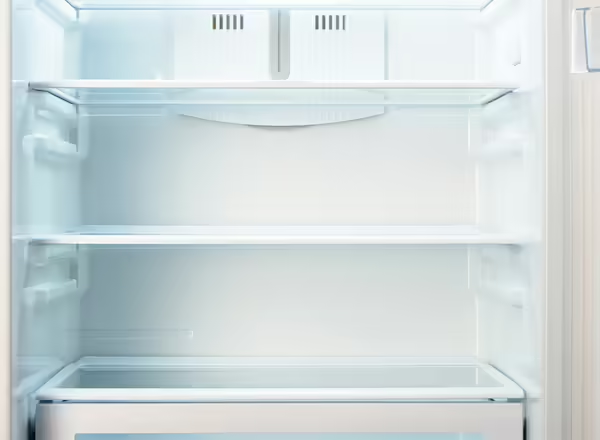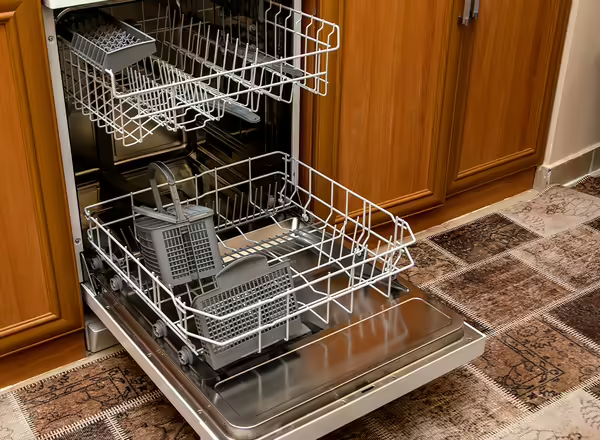Title
Clean and Sanitize the Kitchen
All surfaces that food touches should be kept clean as an essential step in preventing foodborne illness. Harmful bacteria left behind by raw foods can be spread easily, causing cross-contamination. Eliminate bacteria by regularly washing and sanitizing sponges and cloths, work surfaces, countertops, sinks, and appliances.
Tip: Take a Two-Step Approach
Cleaning Guidelines
Always follow manufacturer instructions for cleaning and sanitizing equipment; however, below are general guidelines for cleaning and sanitizing various contact surfaces and equipment.
Food Storage Containers
Do not put storage containers in the dishwasher unless the product is marked dishwasher safe. If no instructions for cleaning are listed, wash in warm soapy water, paying attention to crevasses and indentations where food can get stuck. Rinse thoroughly and dry completely before storing.
Microwaves
Do not use oven cleaner, steel wool, or abrasive cleaners in a microwave. Always follow the manufacturer's instructions. To remove caked-on food, heat one of these options in the microwave, in a microwave-safe dish, until the mixture boils:
- 6 Tablespoons baking soda with 1 cup water, OR
- ½ cup lemon juice with 1 cup water
Leave the mixture in the microwave with the door closed until it cools. Remove the mixture and wipe the microwave with a cloth or paper towel.
Ovens
Before cleaning an oven, make sure it is cool and no pots or pans are inside. Follow manufacturer instructions.
Oven cleaners made for a cold oven are more potent than those made for a hot oven. Pay close attention to the recommendations on cleaners. Do not use oven cleaners on self-cleaning ovens, as this may damage the oven’s surface.
Another method for cleaning an oven is placing ½ cup of household ammonia in a bowl and putting it in a cool, closed oven overnight or for at least 4 hours. After 4 hours, remove and wash racks in warm, soapy water to remove burned-on food.
Wash oven walls and doors with a mixture of ½ cup ammonia and 1 quart of warm water. Wipe down the oven walls and doors. Finally, wash the oven walls and doors one last time with warm, soapy water, rinse, and wipe dry.
Refrigerators and Freezers
Before cleaning a refrigerator or freezer, store perishable food temporarily in a cooler to prevent harmful bacteria from growing. Discard spoiled or questionable food.
- Remove shelves, drawers, and removable parts. Wash with hot, soapy water.
- Wash doors and interior with hot, soapy water.
- Rinse all surfaces using a clean cloth and diluted bleach solution (see table below).
- Dry surfaces completely before replacing shelves, drawers, and removable parts.
| Ingredient | Amount |
|---|---|
| Water | 1 Gallon |
| Unscented, household bleach | 1 Tablespoon |
Sinks and Disposals
Weekly
Wash and disinfect the kitchen sink with either a disinfectant cleaner or a mixture of 1 Tablespoon regular, unscented household bleach per 1 gallon of water. Wash sink strainers weekly.
Monthly
Sanitize drains and disposals by pouring 1 Tablespoon of bleach mixed in 1 quart of water down the drain.
Sponges, Dishcloths, and Pot Holders
Reusable textiles and cleaning items can harbor harmful bacteria and carry viruses. Regularly launder dishcloths and potholders on hot cycles in a washer and dryer. Keep sponges clean using one of the methods below:
- Bleach Solution: Mix ¾ cup of regular, unscented household bleach with 1 gallon of water. Soak sponges in the solution for 5 minutes. Rinse thoroughly. Allow to air dry before using.
- Dishwasher: Include sponges in a wash cycle; temperature should reach 155 F, and include a heated dry cycle.
- Microwave: Microwave a wet sponge for 2 minutes. Let it air dry before using. To reuse the sponge, run it through a dishwasher cycle. Do not microwave a dry sponge; this can cause a fire. Do not microwave metallic padded kitchen sponges.
Title
DIY Bleach Sanitizer Solution
Washing surfaces with soapy water will not kill all the bacteria that can spread throughout food surfaces in the kitchen while preparing food. Make a safe and effective sanitizing solution at home to clean surfaces, countertops, and appliances after cleaning to eliminate bacteria completely.
Make Sanitizer at Home
Mixing Amounts
| Amount of Liquid Bleach | Amount of Cool Water |
|---|---|
| 1 Tablespoon | 1 gallon |
| 1 cup | 5 gallons |
Supplies Needed
Mixing Instructions
- Place bucket or spray bottle on a flat surface.
- Add measured cool water to the container.
- Carefully pour the measured amount of bleach into the container. Consider using a funnel when filling a spray bottle.
- Use masking tape and ink pen to label the container to read “bleach sanitizer” or something similar.
Applying Sanitizer
Clean all surfaces with hot, soapy water BEFORE using sanitizer on that surface. Food particles, soiled or sticky surfaces, and other contamination can deactivate the bleach in your sanitizer.
- Wear rubber cleaning gloves to protect hands.
- Spray solution onto surfaces using a spray bottle, or apply from a bucket using a clean cloth or single-use paper towel.
- Allow sanitizer to air dry.
Safety Tips
Remove Lingering Odors

Refrigerator Odors
- Wipe down the appliance with a 1:1 ratio of vinegar and water to destroy mildew.
- Stuff the refrigerator or freezer with old rolled newspapers. Leave it closed for several days before cleaning with vinegar and water.
- Place a large shallow container of fresh coffee grounds or baking soda on the bottom of the appliance.
- Soak a cotton swab in vanilla, and place it inside the refrigerator or freezer with the door closed for 24 hours.

Dishwasher Odors
Always follow specific manufacturer instructions. Below are suggestions from *Whirlpool® & Kenmore® appliance companies for removing odors from a dishwasher using vinegar and baking soda:
- Clean the filter at the bottom of the dishwasher for food, debris, glass, or other obstructions.
- Pour 2 cups of white vinegar into a glass measuring cup and place it upright on the dishwasher’s lower rack. Do not add detergent.
- Run a normal cycle with heated dry off.
- After the cycle is complete, sprinkle 1 cup of baking soda in the dishwasher. Run another hot water cycle.
- If available, use the home dishwasher sanitizing cycle for cleaning non-porous materials such as acrylic or glass.
*University of Illinois Extension provides this information as a courtesy and does not endorse any company, products, or services over another.